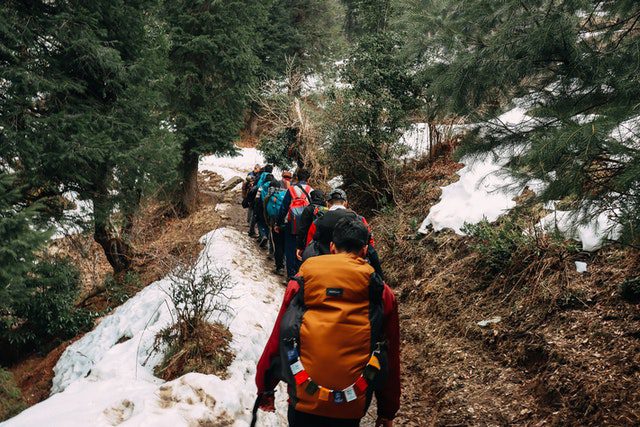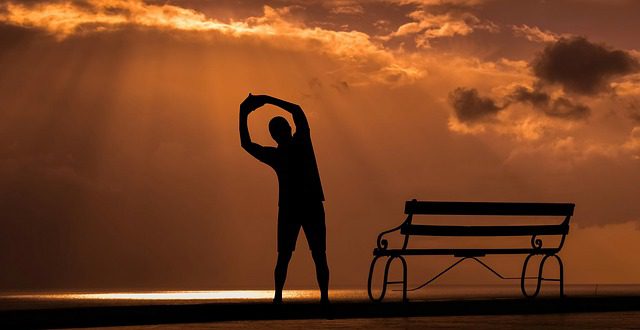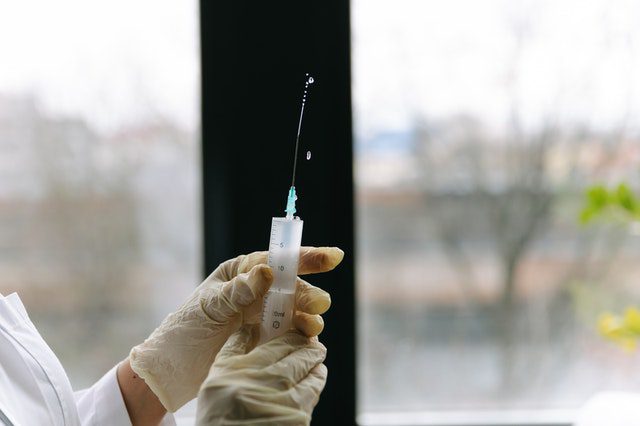

Knee Pain After Hiking: 7 Causes and Quick Fixes!
Hiking is a great exercise and outdoor activity sought by many outdoor and fitness enthusiasts. It, however, comes with a few negatives in terms of hiking-related pain.
One of these is knee pain. Knee pain during and after hiking is one of the most common problems experienced by hikers and is mostly due to overuse and less recovery time.
There are, however, other causes of knee pain after hiking that may be less common.
The anatomy of the knee
The knee is one of the most important parts of the body for mobility, support, and locomotion. It is made up of different parts that work together to perform the general functions of the knee.
The knee joint is made up of:
- Three bones;
- The tibia, femur, and patella
- Ligaments;
- The anterior cruciate; Located at the center of the knee; controls the rotation and forward movement of the lower leg.
- Posterior cruciate; Located at the back of the knee, it controls the backward movement of the lower leg.
- Lateral collateral ligament (LCL); Gives stability to the outer knee.
- Medial collateral ligament (MCL): Gives stability to the inner knee and prevents buckling.
Injury to the ligaments can cause pain and instability when the knee is under pressure.
- Tendons;
They connect muscle to bone. They include the following:
- Iliotibial band
- Quadriceps tendon
- Patella tendon
- Hamstring tendons
It is important to understand the anatomy of the knee to understand knee pain after hiking.
Causes of knee pain after hiking

Knee pain after hiking can result from a few reasons. Some of them may be underlying while some may come up as a result of the hike.
They include:
- Bursitis of the knee
Bursae are fluid-filled sacs found in the moving parts of the body's joints to reduce friction. Inflammation of one or more of the bursae of the knee could lead to bursitis.
It commonly occurs on the inner side of the knee below the knee joint or over the knee cap. It limits mobility and causes pain during movement.
Symptoms
Signs and symptoms vary with each patient depending on the cause of the inflammation as well as the bursae affected.
It is characterized by pain during movement or rest, and the affected area might feel warm and tender or even be swollen.
Causes
When hiking, it may be caused by friction and inflammation due to overuse and fewer periods of rest after hiking. The pain, therefore, begins slowly and gradually worsens with time.
It may also be caused by frequent pressure on the knee, such as using your knees for hiking difficult terrain. It can cause knee pain after hiking due to the frictional stress on the knee joint.
- Tendinosis
Tendons are tough, fibrous connective tissues that attach muscles to bones. They aid in the movement of limbs and also absorb some impact when the muscles are under pressure.
Tendinosis of the knee tendons occurs when the tendons degenerate and develop small tears or have disorganized collagen fibers. The hardening, scarring, or thickening of the knee tendons causes pain and reduced flexibility of the knee joint.
Symptoms
The symptoms vary with the progression of the damage and the extent of the damage. It is characterized by localized swelling and burning pain at the site of the injured tendon.
Pain occurs during hiking and after hiking that may persist for several months. It causes stiffness in the knee joint and restricted movement.
Causes
It is caused by overuse of the knee-tendon or trauma such as falling. It may also be caused by little recovery after hiking and hiking for long periods after a long period of rest.
It is therefore common in professions or activities such as hiking that put the tendons under repeated stress, causing knee pain after hiking.
Tendons take a while to heal (3 to 6 months) because the blood supply to tendons is low. Physical therapy and other treatment options may prove effective for quicker results.
- Knee tendinitis
This is also known as patellar tendinitis or jumper's knee. It is an injury to the patellar tendon, which connects the shin bone to the kneecap.
The patellar tendon is responsible for movements such as kicking, running, and jumping. It may be caused by frequent jumping when hiking, which puts repeated stress on the tendon, causing tears and weakening of the tendons.
Tendinopathy results from the persistence of patellar tendinitis that goes for more than a few weeks.
Symptoms
When you have knee tendinitis, you will feel a burning sensation in the knee cap that may also have swelling.
Causes
It is caused by repetitive stress on the knee and may occur during long periods of hiking, landing on the knees after a fall, or jumping from great heights.
- Meniscus tear
The meniscus is c-shaped tough cartilage that acts as a shock absorber between the shin bone and the femur. A meniscus tear occurs when the knee is suddenly twisted while bearing weights.
Symptoms
It is characterized by pain, swelling, and stiffness of the knee, and it may be hard to fully extend the knee. You may also feel a popping sensation during movement and experience a locked knee.
A small tear may show after 24 or more hours, and you should pay attention to the pain instead of waiting it out. Contact your doctor if your knee isn't moving as it should or if there is pain and swelling.
Causes
It is caused by forceful twisting of the knee, such as a fall when hiking.
- Iliotibial band syndrome
The IT band extends from the hip all the way to the knee cap.
Fibrous tissue makes up the bulk of it. When walking uphill, knee pain might cause irritation of the iliotibial band due to frequent knee flexion.
Causes
When hiking uphill, the IT band rubs on your knee, resulting in greater pain and inflammation. Inflammation in the knee generates swelling and lateral soreness across the kneecap, which is more pronounced while you are climbing uphill.
Treatment
Rest, ice, and anti-inflammatories are the first steps in treating IT band syndrome.
Stretching and strengthening tight muscles, strengthening weak muscles, and correcting abnormal biomechanics are all common goals of physical therapy.
A steroid medicine injection may also be administered by your doctor to treat the knee pain after hiking.
Surgery may be required if more conservative methods of treatment are ineffective.
- Patellofemoral pain syndrome
Patellofemoral pain syndrome (PFPS) is one of the most prevalent knee disorders, and you'll feel it most severely while you're hiking uphill.
Walking downhill might induce knee pain if you have runner's knee or hiker's knee.
Causes
The tibia and femur move while we hike, putting pressure on the kneecap. The tissue around the patella can get inflamed when too much stress is applied to the kneecap.
Patella-femur friction can occur when you walk up an incline because of the constant bending and straightening of your knee joint.
PFPS symptoms are most commonly associated with the knee. However, the problem can also begin in the ankle or hip.
Kneecap alignment can be affected by muscle imbalances and foot arch position.
Treatment
Rest from hiking and aggravating activities, and ice your knee for 15 to 20 minutes every few hours for the first few days. You may be advised to take anti-inflammatory medication by your doctor.
As soon as the discomfort diminishes, you can begin strengthening workouts for the quadriceps, the four-leg muscles that support the kneecap.
Conservative treatment for patellofemoral pain syndrome is usually effective, and a small minority of individuals may require surgery to resurface the underside of the kneecap after treatment has failed.
- Synovial plica syndrome
The plica is a fold in the tissue around the knee that is filled with synovial fluid and surrounded by the synovial membrane. Most of the time, the plica in the middle of the knee becomes inflamed due to overuse resulting in medial plica syndrome.
Different kinds of knee pain when hiking.

When hiking, there are periods that you may experience pain or more pain. The pain may occur as a result of a change in slope or the angle at which the downward force of your weight is applied to your knee.
Knee pain after hiking can also persist as a result of the pain during hiking. Two of them include:
- Downhill Pain
Pressure is the primary cause of knee pain when walking downhill. When you're hiking downhill, you're putting greater stress on your knees because of the additional weight you're carrying.
It can also be caused by:
- Strength as a whole
- Hyper-extending your knee by overextending your muscles
- Leg muscles that are weak or imbalanced
The choice of shoes also affects the possibility of this pain. The support and cushioning provided by your hiking boots will go a long way toward reducing the compressive load on your knees.
2. Uphill Pain
Hiking on steeper inclines, which generally needs more effort, can cause acute knee pain.
It can be caused by chondromalacia (the kneecap's tissue degradation). For people who have worn down or damaged cartilage in their knees, the bone may rub on rough cartilage when the knee bends and straightens.
How to protect the knees when hiking
Hiking is a fantastic opportunity to improve your mood, get some fresh air, and test your physical and mental limits.
Even seasoned hikers are aware that the physical demands of hiking can take a toll on your knees.
When it comes to hiking, it doesn't have to be painful. Learning how to properly care for and preserve your knees while out hiking will help keep you in good health, happy, and pain-free!
- Wear the Right Shoes
Your feet and ankles absorb the first impact of each step you take, followed by your knees, hips, and back. Your knees will certainly hurt if your steps aren't appropriately cushioned and supported.
Knee pain after hiking might be caused by shoes that don't fit properly or impair your posture and motion. Hiking requires proper footwear to safeguard your feet, ankles, and knees.
It's critical to put on the proper footwear.
The soles of your hiking boots or shoes should be properly cushioned to withstand the shock of the ground.
- Hike in a Switchback Pattern, if Possible
Your knee cap may take the brunt of the impact if you hike downhill on steep terrain. This can cause more than just pain; it can also cause damage.
An uphill switchback path is one that zigzags its way to the top of a hill or hillside. The slope is approached via a series of switchbacks that go from one side of the hill's face to the other before turning around and going the other way.
"Switchback" has been around for a long time; even if you're not an avid outdoorsman, you may have used it unknowingly one or twice.
- Slow down and avoid leaning
Avoid jumping from great heights when hiking as it may cause knee problems such as patellar tendinitis. Pay attention to how you're standing, as kneecaps are more vulnerable to injury if you lean back when hiking downhill.
If you can, slowly descend the height and use your hiking pole. Zigzag your path, and slow down to help preserve your knees from knee pain after hiking.
- Stretch before and after hiking

Warming up before hiking stretches the muscles, ligaments, and tendons to increase their range of motion and flexibility. Focus on slow but extensive stretches that promote flexibility and mobility.
Stretching after hiking relieves stress on the strained parts of the knee and reduces soreness that may occur from putting the knee under repeated pressure.
Doing this also promotes blood flow and, therefore, nutrient supply to these parts of the leg, quickening recovery.
- Invest in good hiking gear
Hiking is a physically involving activity that is also unpredictable. There is a high chance you will use your knees to help you scale some difficult terrains as well as suffer one or two falls.
Knee braces protect your knee from mechanical damage and also make it comfortable when using your knees on hard surfaces.
Hiking poles distribute the pressure on your knees as you lean on them for extra support. This is handy when hiking downhill as a hiking pole can help your shoulders and arms absorb some of the shocks from the impact.
- Avoid using your knees to climb
As much as it seems effective to overcome treacherous terrain by using any means possible, using your knees when hiking can damage them. Frequent, sustained pressure by the knees, especially from rough terrain, causes damage to various parts of the knee and may even cause skin breakage.
You can use knee braces when hiking over hard surfaces to protect your knees from mechanical damage. It may be prone to injury, especially if you slip and graze or cause trauma to the knee.
- Ditch the heavyweight
You don't need that extra piece of equipment for a short hike. Only carry essentials and what you know you will need or use during the hike.
You can also lighten the load of your essentials, such as carrying smaller sunscreen bottles and lighter water pouches instead of water bottles. If you won't need your tent, there is no need to carry one for a half-day hike.
While you lighten your load, ensure you stick to the hiking trails and the group so that you don't stray away with a few essentials.

Treating knee pain after hiking

If you experience knee pain after hiking, there are a few ways you could alleviate the pain. Some of them can be done at home, while others may require medical intervention.
Home remedies
Home remedies are handy when it comes to mild pain. some of them include;
- Cold and heat treatment
- Massages
- Knee elevation
- Exercise
- Rest
There are other methods that can be done at home or in other designated areas.
Physical therapy
Physical therapy, or rehab, as it is sometimes referred to, can help relieve muscular and joint pain.
Physical therapists are qualified professionals who can help you strengthen your muscles and improve the way your body feels and moves using a range of techniques.
They include:
- Stretches and exercises
- Ice and heat
- Ultrasound massage
- Extracorporeal shockwave therapy (EWST)- This involves the application of pressure waves to the surface of the skin to promote regeneration of tissue, therefore, speeding up healing.
Medical remedies
- Knee injections
- Medications
Your doctor may prescribe medicine to alleviate your symptoms and treat the underlying problems.
- Surgery
This is an invasive procedure that is the last resort to severe knee pain. It is often advised after other alternative forms of treatment have proved ineffective.
Frequently asked questions
How Do I Strengthen My Knees for Hiking?
When hiking outdoors, hikers should always be prepared for the possibility of getting hurt. Ignoring minor discomforts can lead to more serious health issues down the road.
Preventing injuries begins with a solid strength training program.
You can strengthen your glutes and stabilize your knees while hiking by working on your hips, back, and thighs. These muscles offer extra support to the knee.
How can I relieve pain in the knee after hiking?
There is no doubt that some pain will be experienced after a long hike. It can be anywhere from muscle soreness to other conditions discussed above.
There is a simple drill you can use to help reduce pain in the knee from hiking. This is the RICE drill:
Step 1: Rest
Step 2: Ice
Step 3: Compression
Step 4: Elevate
About Dr. Sean Ormond



